- Quick Read
- Deep Read ( 13 Min. )
In Today’s Issue
- In Arizona, voters want tighter borders. Will this issue swing the election?
- Today’s news briefs
- Europe is trying to cut back migration. Can it find a legal way to do it?
- Amid 2024 election, civics classes prove a draw for high schoolers
- Sifting hopes and realities for Election 2024
- Many Nigerian girls have been forced to leave school. Mentors help them return.
Monitor Daily Podcast
- Follow us:
- Apple Podcasts
- Spotify
- RSS Feed
- Download
TODAY’S INTRO
A glimpse of a world where peace is growing
 Mark Sappenfield
Mark Sappenfield
Every day, news tells the story of how peace seems to be in retreat. The challenges are significant. But there is also another view. Last week, people from around the world gathered in Geneva for Peace Week. Columnist Keith Collins was there and caught a glimpse of what the world looks like when peace is the priority. You can read the story here.
Share this article
Link copied.

Help fund Monitor journalism for $11/ month
Already a subscriber? Login

Monitor journalism changes lives because we open that too-small box that most people think they live in. We believe news can and should expand a sense of identity and possibility beyond narrow conventional expectations.
Our work isn't possible without your support.
In Arizona, voters want tighter borders. Will this issue swing the election?
On Arizona’s southern border, there’s both public division and common ground over immigration. Part of a series on the issues that may tip key swing states: Georgia, Michigan, Nevada, North Carolina, Pennsylvania, and Wisconsin.

-
Riley Robinson Staff photographer
In the battleground state of Arizona, where the divisive issue of immigration is a top voter concern, rancher Jim Chilton and volunteer Gail Kocourek are political opposites. He’s for Donald Trump. She backs Kamala Harris.
The two are also friends. And the two are meeting at his cattle ranch before she sets out with a new volunteer to check out aid stations along the southern border.
Peel away the politics of border security and immigration, and ideology submits to practicality in this border state – and across the United States. Trump and Harris supporters now align closely on improving security along the country’s borders, according to an August survey by Pew Research Center. Majorities also agree on admitting more high-skilled immigrants.
But Julianna Larsen isn’t holding her breath for Washington to act. Just over a year ago, she founded a nonprofit, the Arizona Refugee Center, that serves as a classroom, supply center, and food bank for migrants. It’s triage every day, says Ms. Larsen.
Everyone wants a secure border, she says. But politics seem to get in the way.
“I can’t wait for Washington to fix anything,” she says. “I have people right in front of me that need me.”
In Arizona, voters want tighter borders. Will this issue swing the election?
In the battleground state of Arizona, where the divisive issue of immigration is a top voter concern, rancher Jim Chilton and volunteer Gail Kocourek are political opposites. He’s for Donald Trump. She backs Kamala Harris. He’s for a border wall. She’s against it. Yet they have found a way to partner on the polarizing subject of border security by working to prevent the deaths of border crossers, thousands of whom traverse Mr. Chilton’s desert ranch.
The two are also friends.
“We have common ground on humanity. That’s why he and I get along,” says Ms. Kocourek, a volunteer with the Tucson Samaritans, a humanitarian group that provides water, food, and first aid along the border. “She’s a terrific human,” he says with a twinkle from under his cowboy hat. The two are meeting at his cattle ranch before she sets out with a new volunteer to check out two aid stations along the border.
Peel away the politics of border security and immigration, and ideology submits to practicality among many voters in this border state – and across the United States. That’s particularly true when it comes to order on the border. In the wake of record illegal migration that overwhelmed southern communities, and northern and western cities such as New York and Denver, Trump and Harris supporters now align closely on improving security along the country’s borders, according to an August nationwide survey of registered voters by Pew Research Center. Large majorities also agree on admitting more high-skilled immigrants.

“Americans are more aligned generally on what they want to see from immigration than you hear from pundits, advocates, or even politicians,” says Theresa Cardinal Brown, senior adviser on immigration and border policy at the Bipartisan Policy Center in Washington. They want a fair process, and migrants to abide by it, she says. And, she adds, “Majorities [in] both parties are perfectly fine giving folks who have been here a long time a path to legal status.”
But the security gap – and Mr. Trump’s clear dominance on this issue – has forced Democrats to change their tune. Four years ago, Joe Biden and his running mate campaigned on the humanitarian treatment of migrants. Today, Vice President Harris stresses her background as a former California prosecutor who was tough on cartels and, as president, would be equally tough on border security. When she ran for president in 2019, she promised to make illegal border crossing a civil offense. Now she pledges to pursue “more severe criminal charge against repeat violators.” She also backs more restrictions on asylum.
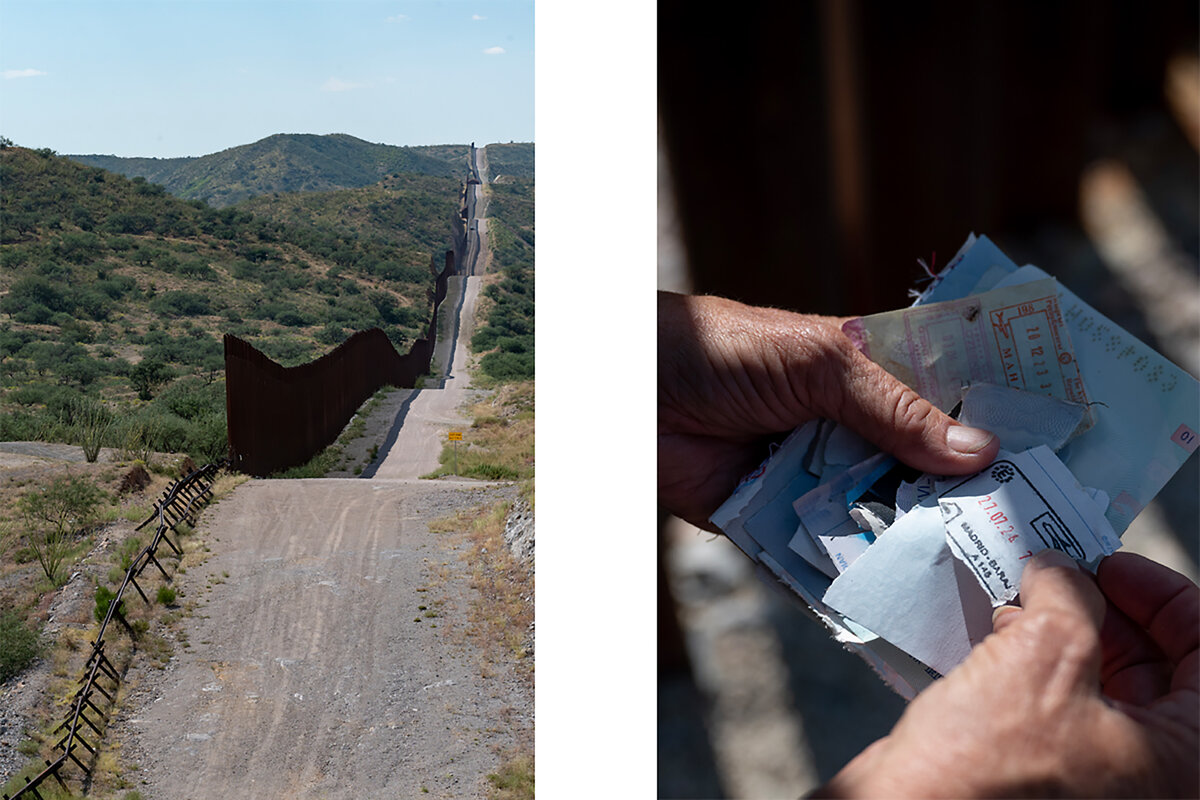
“She has moderated significantly in her baseline position on immigration,” says pollster David Byler, of Noble Predictive Insights in Phoenix. In Arizona, as in the nation, immigration is a top voter issue along with the economy, and polls show that voters put more trust in Mr. Trump to handle these twin concerns than they do in Ms. Harris. “Trump is in his sweet spot” on immigration, says Mr. Byler. “She understands that this is a weakness for her and is acting accordingly.”
Common ground on the Chilton ranch
When Mr. Trump descended that golden escalator in 2015 and promised to build a great wall on the border with Mexico, he had an immediate convert in Mr. Chilton, a fifth-generation cattle rancher. About 5 1/2 miles of his sprawling ranch abut the U.S.-Mexico border. When he and his wife, Sue, bought the place nearly 40 years ago, “the wall” was a four-strand wire cattle fence. Today, a ribbon of Trump-administration steel slats runs along most of the line that his ranch shares with Mexico.
But not along all of it. Construction of the last half-mile stopped with the Biden administration. That makes it an easy path for drug and human traffickers. The Chiltons and their cowboys have encountered migrants, drug drops, and drug packers, who sometimes tote AK-47s. Burglary is also a problem, and discarded plastic bags can kill cattle that ingest them. Worst of all are the human deaths – a total of 35, three in the last year, including an obvious cartel beheading.
Since Mr. Biden became president, the Chiltons’ motion sensor cameras have recorded 3,550 migrants and drug packers crossing on their ranch – five times more than during the Trump administration. The couple want the wall finished – a point they made to thundering applause at the Republican National Convention in July.
“My real issue is that people die on my ranch, and that’s horrifying,” explains Mr. Chilton, seated at his massive dining room table in September.
This is where Ms. Kocourek comes in.
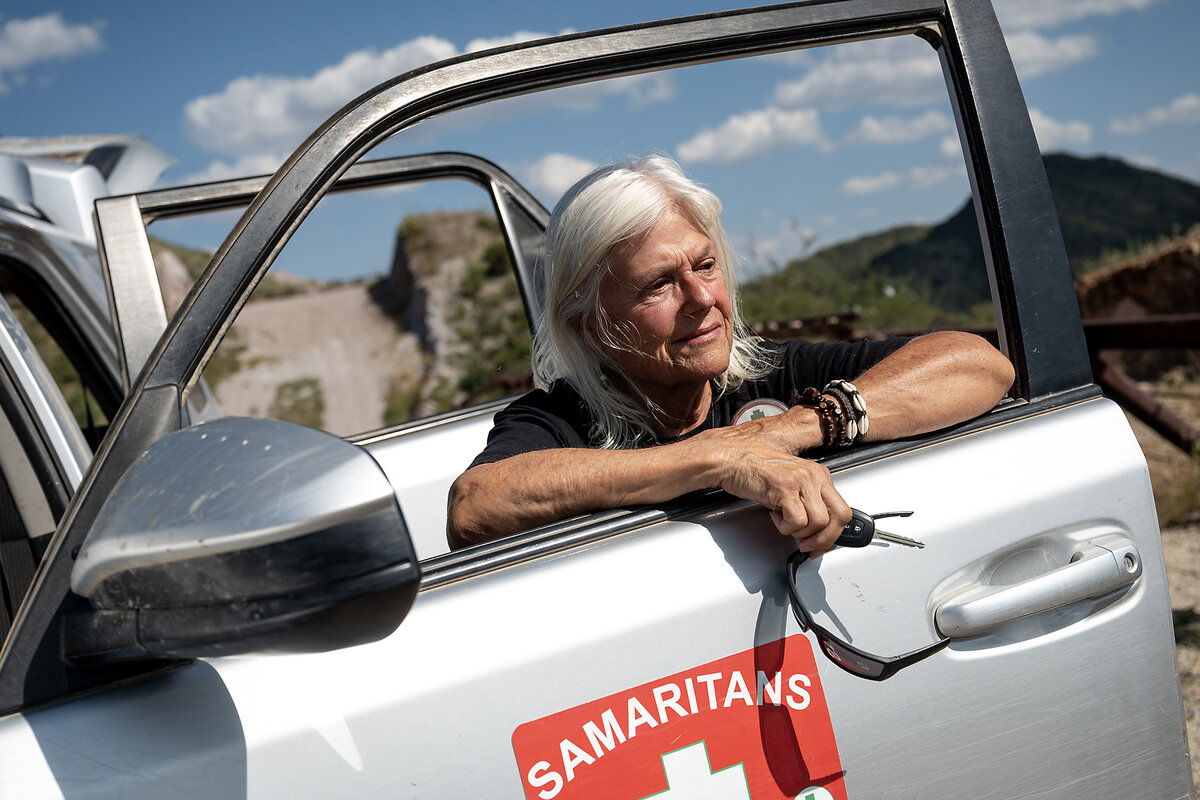
The Democratic precinct captain runs orientation trips for new Samaritan volunteers. The wall is “a money pit,” she states, charging up and down the undulating border road in her Toyota 4Runner. Summer monsoons undermine the wall so much that the Biden administration is installing French drains and paving the deeply scarred dirt track. Ms. Kocourek stops at one of many repaired cuts in the slat wall: A witty welder has chalked the words “job security” with a smiley face above his latest handiwork. Further along the border, a dismantled Clinton-era barrier lies piled to one side. It wasn’t high enough.
Despite their different views, Ms. Kocourek praises Mr. Chilton. It was his idea to mark one of his cattle water tanks near the border with a tall blue flag so migrants could easily spot it. He has installed 29 drinking fountains at wells and on pipes. He calls her and the Samaritans “big-hearted people who feel, as I do, that people shouldn’t die in the desert.”
And they agree on this: America needs immigration reform, including more legal immigrants, because employers are going begging for workers.
Immigration on the Arizona ballot
In this tight race, the Grand Canyon State so far tips toward former President Trump, giving him a slight average edge of 1.8 percentage points. In 2020, Mr. Biden won Arizona by fewer than 11,000 votes. But Arizonans overwhelmingly support a controversial immigration enforcement measure on the November ballot, Proposition 314, according to a poll by Noble. The measure was placed before voters by the GOP-controlled state legislature, after Democratic Gov. Katie Hobbs vetoed similar legislation.
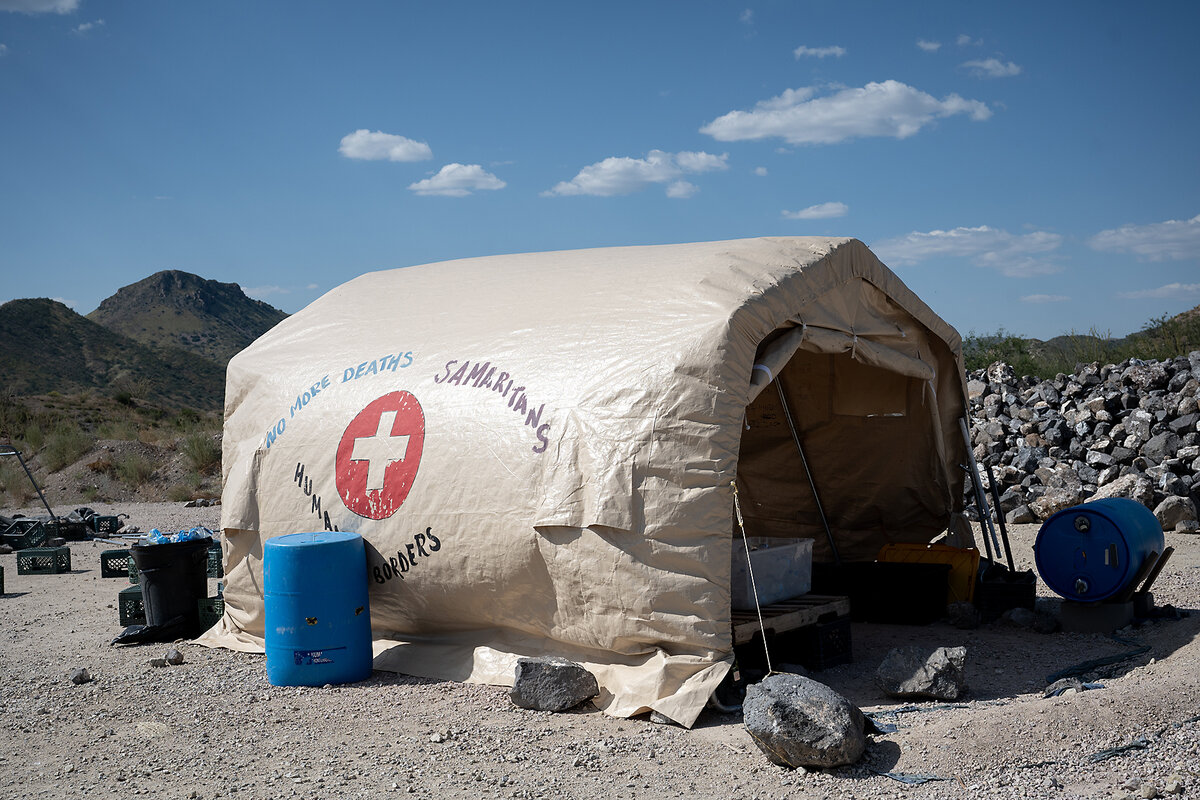
The catchall proposition would make it a state crime for noncitizens to enter anywhere besides a port of entry. It would also allow local law enforcement to arrest those who cross unlawfully and let state judges order deportations. Important to many border security advocates, the measure has a felony component relating to selling fentanyl.
The measure has majority support even among traditionally liberal blocs: college-educated people, Hispanics, Democrats, and young people.
JD Vance rally: “Pack your bags”
It’s a sizzling 110 degrees Fahrenheit in early September, and Republican vice presidential candidate JD Vance is rocking a crowd of about 300 at the Phoenix Biltmore Resort. He starts by criticizing the Biden-Harris administration’s “open border” record, and then says, “I bring a message from Donald J. Trump. If you are in this country illegally, in six months, pack your bags.” Sustained applause follows before he can get to his immigration punch list: restart deportations, finish the border wall, stop the “catch and release” of unauthorized migrants.
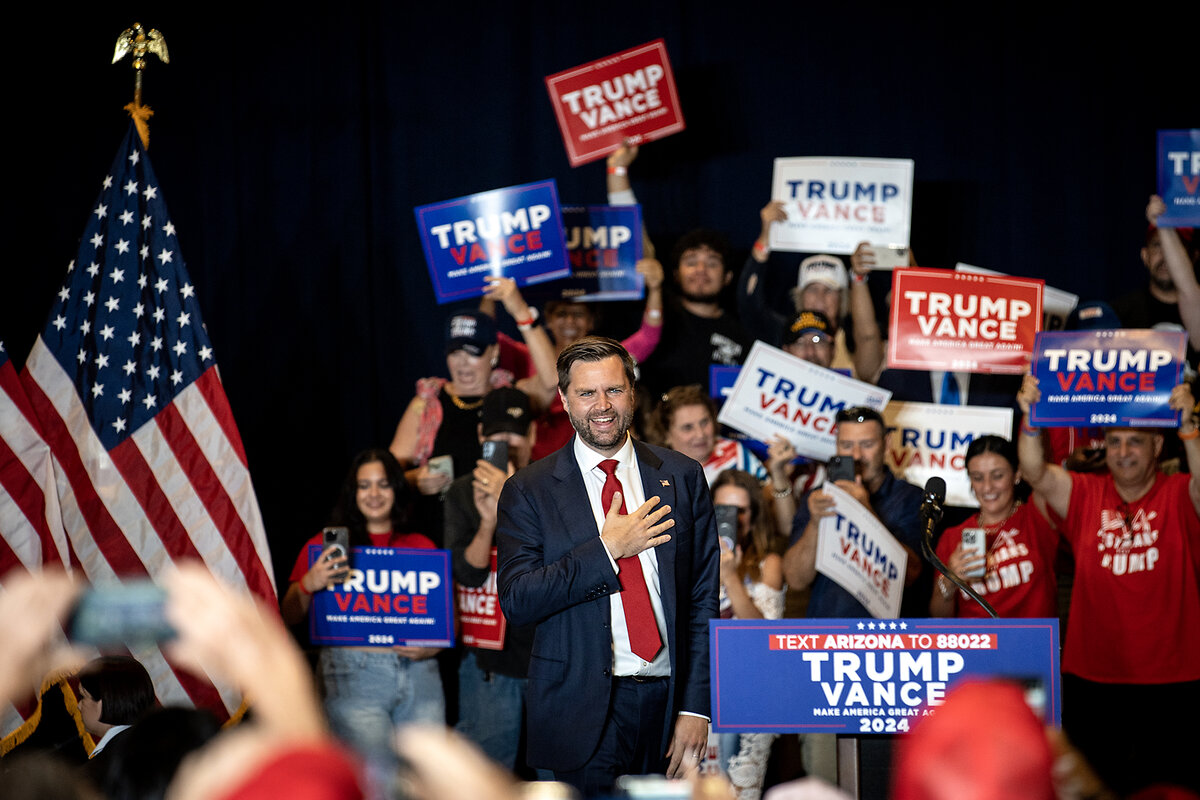
In interviews at the rally, several Trump supporters express worry about cartels and crime.
Brian Kelly, a photographer who lives in Scottsdale, recalls a harrowing incident when driving his black BMW on a dirt road. Suddenly, he was boxed in by “cartel-looking” old vehicles with blacked-out windows. He managed a quick escape maneuver once he reached pavement.
And what of Ms. Harris’ promise to get tough on the border? Does he find her believable?
He laughs. “Kama-Kama Chameleon? No.” She’s flip-flopped so much she might as well don a MAGA hat, he says. “She hasn’t done anything. We haven’t even seen her for the last 3 1/2 years, let alone trust her.”
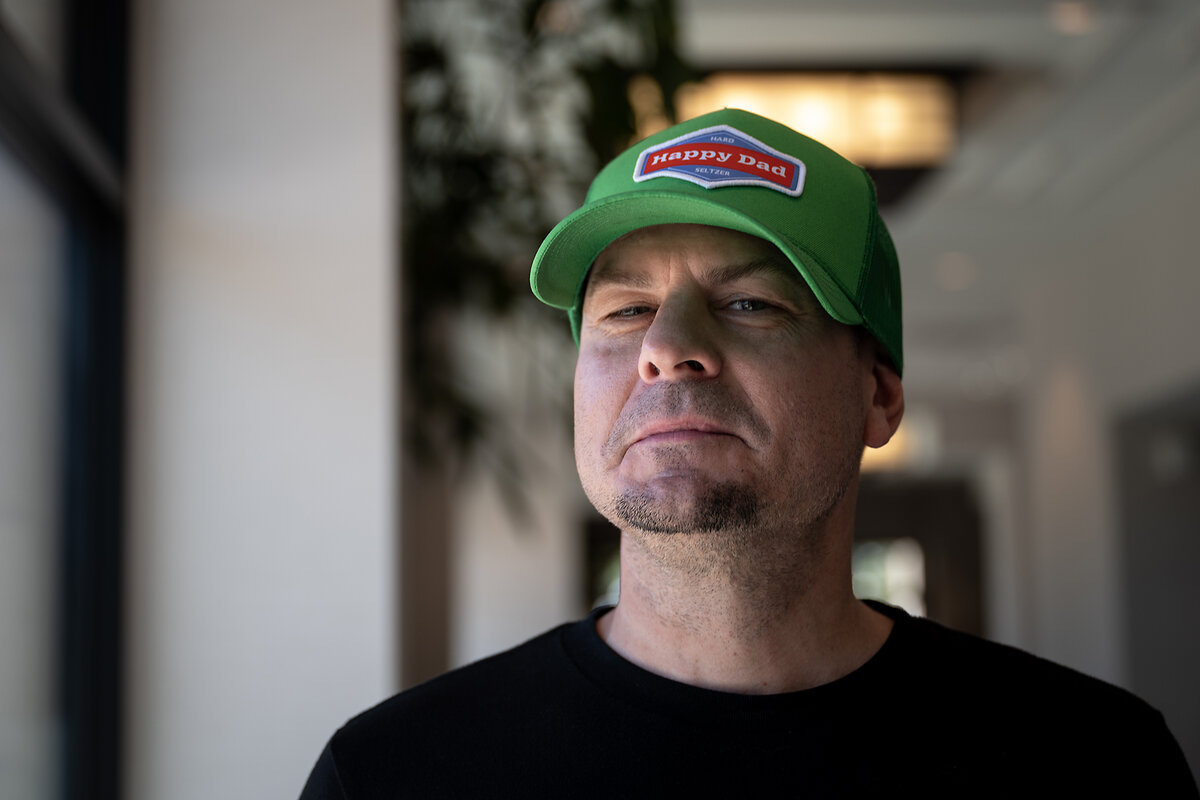
Bipartisan breakdown
In the past, a kind of bipartisan consensus existed among various groups in the two parties, says Ms. Brown of the Bipartisan Policy Center. The thinking was that the way to control illegal immigration at the border was through more border patrol, technology, some amount of barrier, and the ability to quickly deport back to Mexico – where most crossers came from. As recently as 2013, after Republican Mitt Romney lost to Barack Obama, the Republican National Committee recommended that the party embrace comprehensive immigration reform – with security measures paired with pathways toward legal status for unauthorized immigrants already in the country.
But the going enforcement strategy that had been in place for 20-plus years broke down as new population groups arrived, Ms. Brown explains. More people from Central America – and now from much further away – started crossing, including unaccompanied minors. That opened the door for immigration and border security to become highly partisan and “supercharged” under former President Trump.
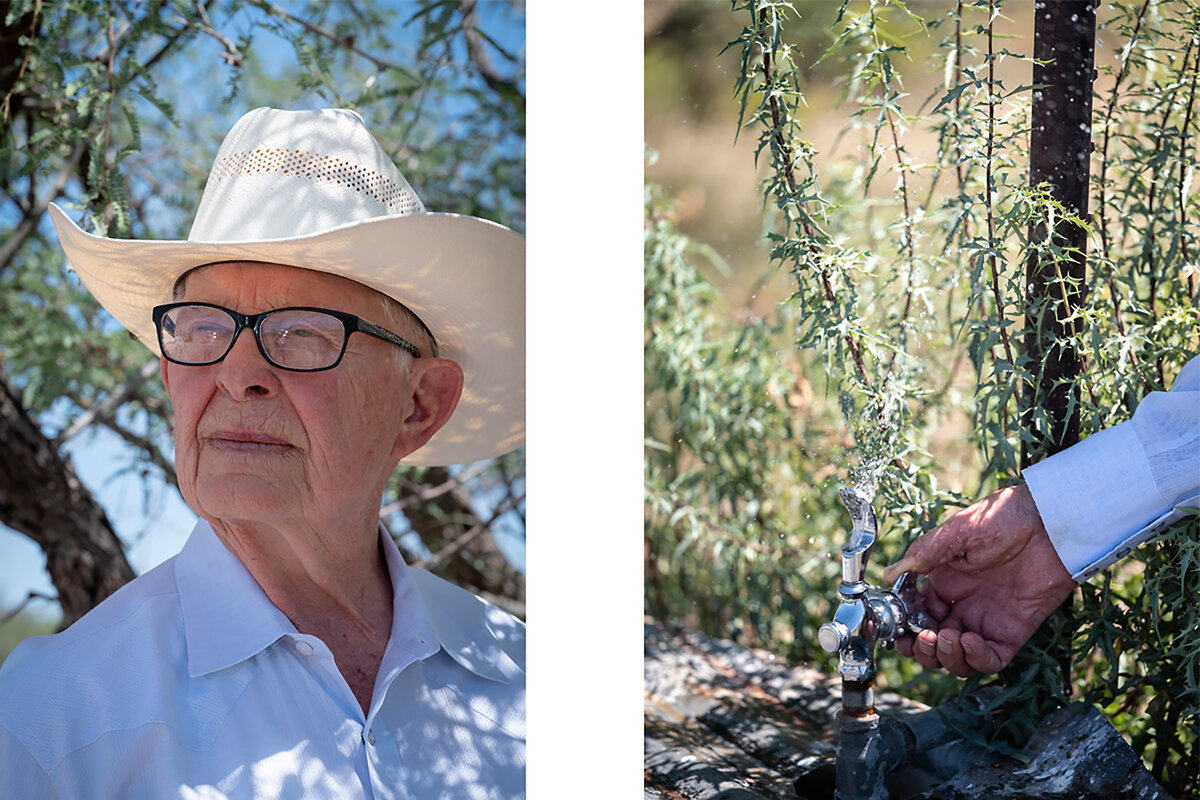
Mr. Trump is campaigning on immigration much like he did the first time he ran for the Oval Office. As president, he slashed refugee levels and, perhaps his most controversial move, separated children from their families as a deterrent to illegal crossings. (The Trump administration eventually backed down from its separation policy, while the U.S. Supreme Court upheld a version of what critics called the “Muslim ban.”) He also built about 500 miles of border wall, much of it replacement fencing, and expelled migrants under a pandemic health policy.
At first, border apprehensions fell, and then doubled – prompting his “Remain in Mexico” policy for asylum-seekers to await their first hearings.
Democrats were horrified by President Trump’s deterrence policies and saw them as a humanitarian issue. “That’s what [Mr. Biden] ran on, and that’s what he did in his first two years in office,” says Ms. Brown. “And the numbers went up and up and up and up and up.”
Consequentially, President Biden at first put deportations on pause and ended his predecessor’s “Remain in Mexico” policy. But he continued pandemic expulsions through the end of the public-health emergency in spring 2023.
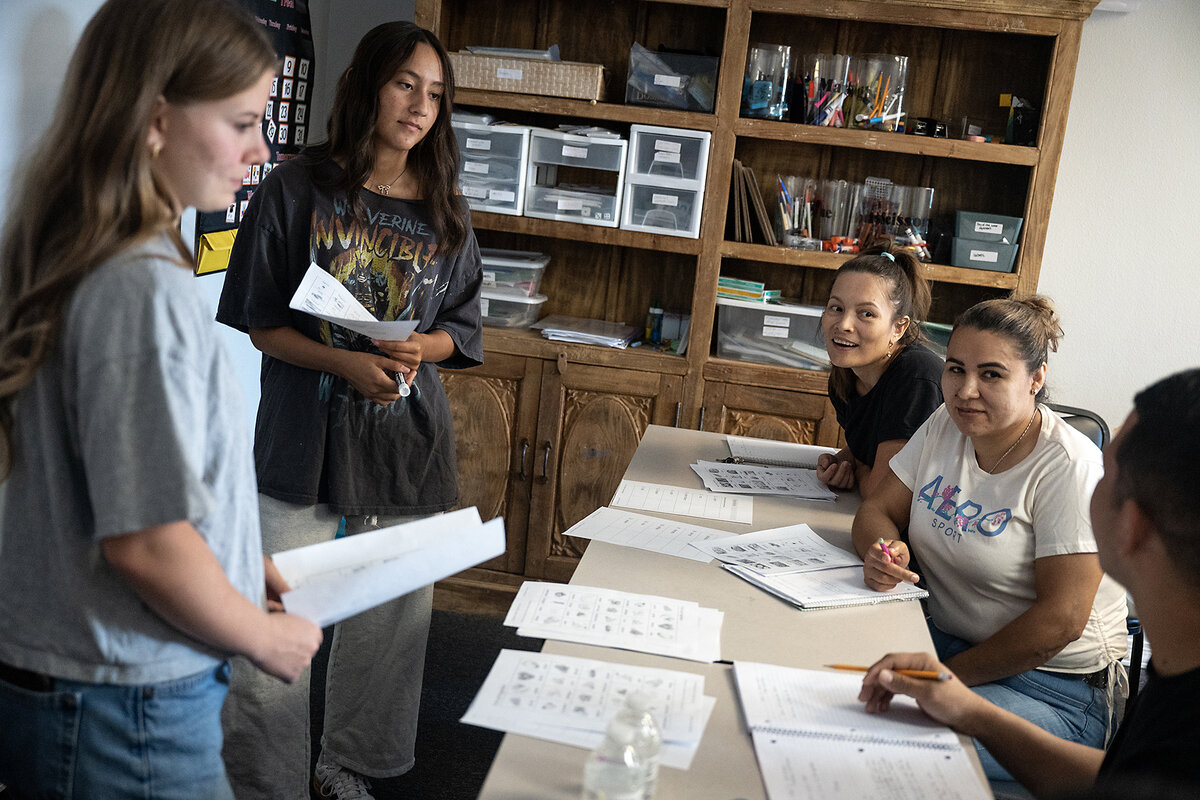
To discourage illegal crossings, the president promoted use of an app at official ports of entry and expanded use of “parole,” which gives noncitizens temporary permission to stay, mostly on humanitarian grounds. The Biden administration has paroled more than half a million nationals from Cuba, Haiti, Nicaragua, and Venezuela, who’ve had to arrive via airports. Conservatives argue that the White House has overstepped its parole authority, creating a “back door” for otherwise unauthorized immigrants to enter the U.S.
Along the southern border, the Border Patrol has tracked more than 7 million unauthorized migrant encounters during the Biden years, compared with some 2 million during the Trump administration. Beginning in June, President Biden significantly tightened access to asylum through executive action. Since then, illegal migration at the southern border has dropped precipitously and is now at its lowest levels since 2020 – likely also due to stepped-up Mexican enforcement.
Harris is walking a fine line
No question, this is a difficult issue for the vice president. Mr. Byler, the pollster, says Ms. Harris’ best path is to keep doing what she’s doing: “sidestep” her record, as she did in the debate with Mr. Trump when she baited him on crowd size; move aggressively to her right so that “immigration is not a disqualifier” for her; and point out Mr. Trump’s extremes – such as his demeaning rhetoric and backing of mass deportations.
That seemed to work when she tried it out at her introductory rally with running mate Minnesota Gov. Tim Walz in metro Phoenix in August. Cheers and applause interrupted her multiple times when she pledged to take on the “broken” immigration system and fix it, promising comprehensive immigration reform, strong border security, and an earned pathway to citizenship. She excoriated Mr. Trump for tanking a bipartisan border bill in the U.S. Senate this year and choosing to run on the issue. She says she will sign the bill if elected.
“Having a protected border is important,” says rallygoer Hector Zamorano, a Mexican American loading up with snacks at the Glendale arena, where at least 15,000 supporters roared approval for the duo. Others interviewed agreed.
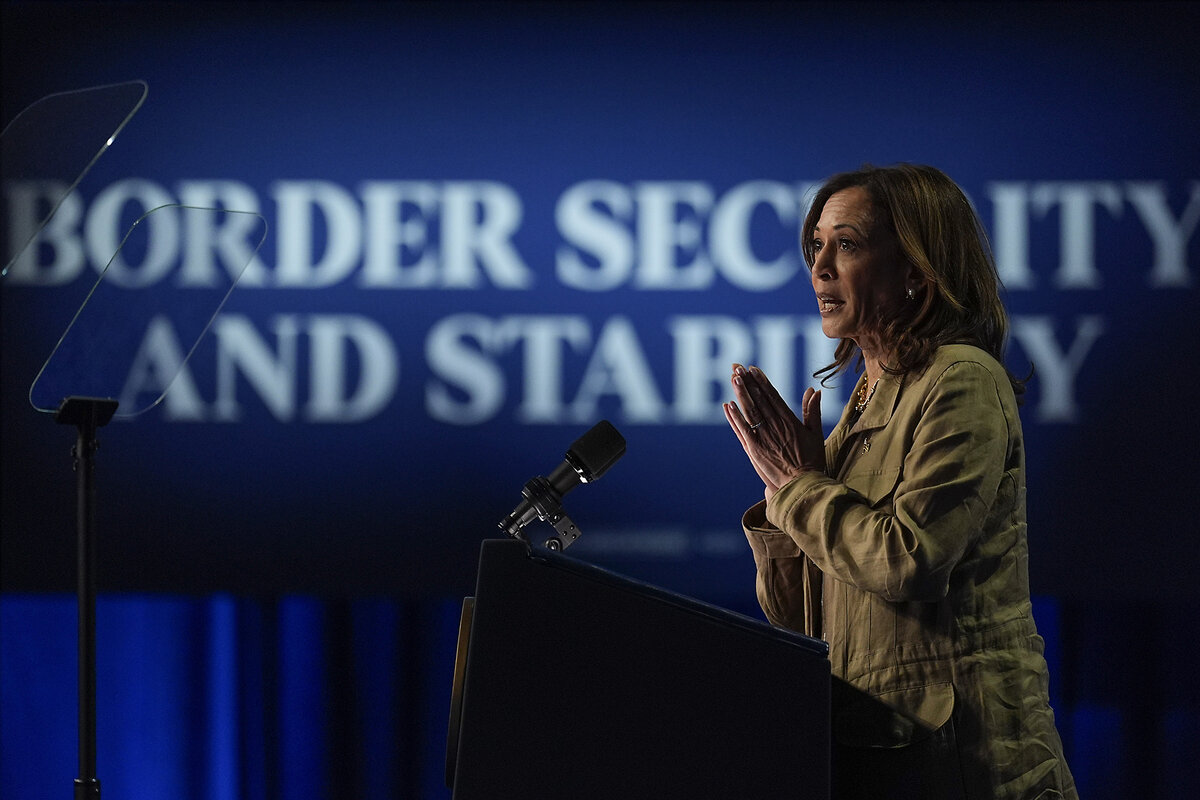
Loyal Trump supporters like those at the Vance rally aren’t likely to suddenly trust Ms. Harris and her new centrist message. But in a contest that hangs on the margins, that message could help her win over persuadable voters who don’t like the former president, says Tyler Montague, a Republican consultant in Arizona who does not support Mr. Trump.
“It might give them permission to vote for her,” he says.
On the other hand, all the tough talk on the border is disheartening to Latinos and others who have long wanted a pathway to citizenship, particularly for “Dreamers” – children of unauthorized immigrants brought to the U.S. as minors. The bipartisan Senate bill that Ms. Harris says she’d sign had nothing in it for “Dreamers” – though it did provide funds for more border patrol and immigration courts, and allow for more building of the wall.
What complicates the picture further is that while Latinos tend generally toward voting Democratic, many have conservative cultural and economic values. As a result, President Trump has made inroads with Hispanics, especially men.
The group as a whole is influential, especially in swing states: In Arizona, 25% of voters are Latino; in Nevada, it’s 20%. While the vice president leads Mr. Trump among Hispanics, she’s not polling as well with them as did Mr. Biden, who also won Nevada.
The Latino share of the electorate is growing, and evolving, says Angel Molina, an associate professor at Arizona State University’s School of Public Affairs. That presents a challenge for the vice president.
Historically, it might have been enough to mobilize them just by taking a pro-Latino stance on immigration, he says. But today’s younger voters want to know there will be follow through. “What’s going to be different about this time?” he asks.
To that end, Dr. Molina notes that when Ms. Harris visited the border recently, she rejected the argument that you can’t have both border security and an earned path to citizenship. “We can do both, and we must do both,” the vice president said.
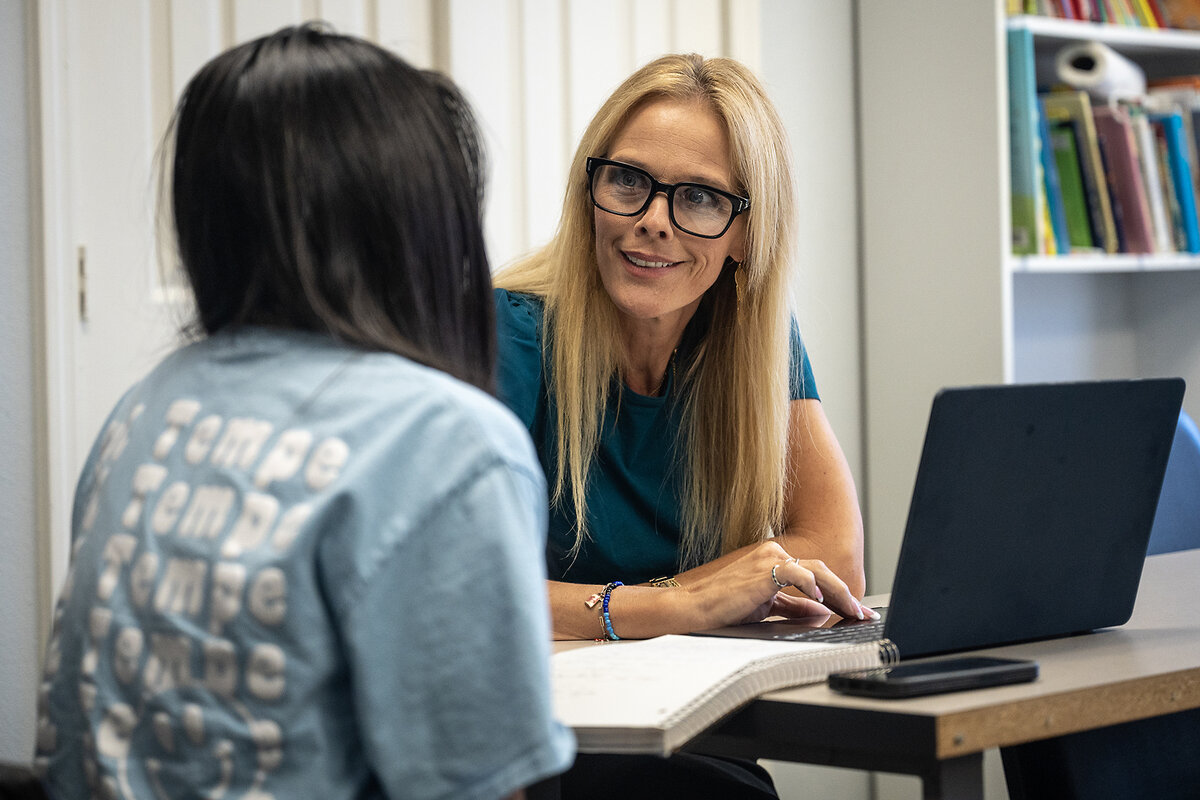
A path forward?
But is that dual track possible? Time and again, immigration deals on the cusp of bipartisan agreement have failed.
Mr. Montague says that when he talks with Republicans off the record, most want to help “Dreamers.” He faults America’s primary election system that rewards hard-liners. Interestingly, Arizonans will have a chance to vote in November on a ballot measure that replaces partisan primaries with open ones. It competes with another ballot measure that anchors partisan primaries in the state constitution.
But Julianna Larsen isn’t holding her breath for Washington to act. Just over a year ago, she founded a nonprofit, the Arizona Refugee Center, in Mesa, the third-largest city in Arizona. The center, sandwiched into a single-story insurance building, serves as a makeshift classroom, supply center, and food bank for migrants. She, a business partner, and several volunteers handle hundreds of cases for Afghan, Venezuelan, Mauritanian, Cuban, and other asylum-seekers. Most have come over the southern border.
On a recent day, all of the dozen or so waiting chairs that line the refugee center’s entry are occupied. In the adjoining room, an Afghan case worker is stuck on hold trying to get a call through to U.S. Citizenship and Immigration Services. In two nearby rooms, adults learn English by explaining how to cook their favorite foods. It’s triage every day, says Ms. Larsen.
The immigration solution seems obvious to her. Everyone wants a secure border. They also want people to be treated humanely. But like so many Arizonans faced with what’s on their doorstep, she says she has no choice but to address the challenge at hand.
“I can’t wait for Washington to fix anything. I have people right in front of me that need me.”
Monitor staff writer Sarah Matusek contributed to this story.
This story is one of a seven-part series on key swing states in the U.S. presidential election and the issues that may tip them. The full series includes articles reported from Arizona, Georgia, Michigan, Nevada, North Carolina, Pennsylvania, and Wisconsin.

Today’s news briefs
• Louisiana Ten Commandments: A new Louisiana law requiring the Ten Commandments to be displayed in every public school classroom is being challenged in court.
• Rohingya refugees: About 140 Rohingya Muslims, mostly women and children, are on a wooden boat anchored about one mile off the coast of Indonesia’s northernmost province of Aceh. Local residents have refused to allow them onto land since Oct. 18.
• Migrants head for U.S.: A group of about 2,000 migrants has left Mexico’s southern border hoping to reach the country’s north and ultimately the United States.
• Peru corruption: Former President Alejandro Toledo has been sentenced to 20 years in prison in a case involving Brazilian construction giant Odebrecht.

Europe is trying to cut back migration. Can it find a legal way to do it?
European countries such as Italy are trying to reduce immigration by moving asylum-seekers’ processing offshore – in Italy’s case, to Albania. But while the approach is increasingly popular, its legality remains suspect.

- Quick Read
- Deep Read ( 5 Min. )
-
Nick Squires Special contributor
Italy’s new migrant-processing centers in Albania had barely opened this week, accepting just 16 young men from Egypt and Bangladesh last Wednesday, before their futures were thrown into doubt.
First, it was determined within hours of their arrival that four of them should be brought to Italy on the grounds that they were either minors or “vulnerable.” Then, on Friday, a special immigration court in Rome ruled that the remaining 12 migrants cannot be sent back to Bangladesh or Egypt because they are not safe countries.
The outcome highlights the difficulties facing Europe’s increasingly popular anti-immigration governments as they search for solutions that don’t run afoul of European laws, which include expansive protections of vulnerable migrants.
Italy last year bore the brunt of irregular immigration into Europe, and Prime Minister Giorgia Meloni came to power on promises to stop smugglers from bringing people into the European Union. The deal with Albania was endorsed by European Commission President Ursula von der Leyen as an example of “out-of-box thinking.”
“Many member states want to pursue a similar model,” says Hanne Beirens, director of the Migration Policy Institute Europe. “The question is not whether the political interest will be maintained, but whether it will be feasible to implement.”
Europe is trying to cut back migration. Can it find a legal way to do it?

Surprised by an unexpected court ruling, Italian Prime Minister Giorgia Meloni is fighting for the survival of her newly inaugurated migrant-processing centers in Albania. Widely hailed as a model by European politicians pushing a tougher line on migration, the project has endured an inauspicious launch.
The first batch of 16 migrants, young men from Egypt and Bangladesh, arrived last Wednesday. Within hours, it was decided that four of them should be brought to Italy on the grounds that they were either minors or “vulnerable,” physically or mentally.
Then, on Friday, the special immigration unit of a court in Rome threw a major wrench in the works of the five-year €670 million ($724 million) plan to process Italian asylum applications offshore. It ruled that the remaining 12 migrants cannot be sent back to Bangladesh or Egypt because they are not safe countries.
The Italian government is furious. “Politicized judges have decided that there are no safe countries of origin: it is impossible to detain those who enter illegally, it is forbidden to repatriate illegal immigrants,” Ms. Meloni’s hard-right party, Brothers of Italy, posted on the social platform X. “They want to abolish Italy’s borders. We will not let them.”
Italy’s deal to process asylum applications in Albania has sparked considerable interest among European policymakers. Since the crisis of 2015-16, migration has become a hot-button issue across the European Union, reshaping domestic politics and fueling division. In Italy, it empowered a strong right-wing government that now sets the bloc’s tone on migration.
“If skeptical views regarding migration and more open borders continue to gain ground among European voters ... this tension between judicial decisions and popular demands could pose a significant challenge for liberal democracies,” says political analyst Teresa Nogueira Pinto, who teaches at the Universidade Lusófona in Lisbon, Portugal.
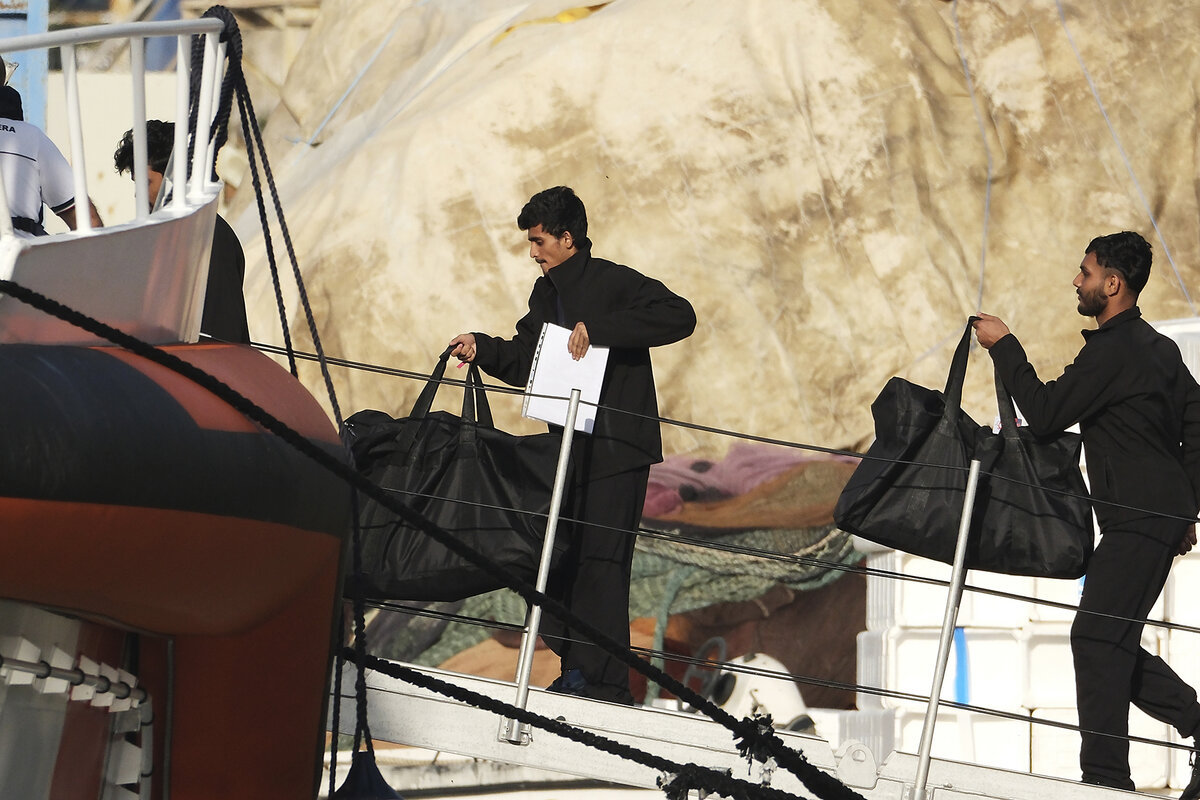
“Out of the box” or out of order?
The Rome court’s ruling followed an Oct. 4 decision by the European Court of Justice, which tightened the definition of what counts as a safe country to which failed asylum-seekers can legally be returned. Countries such as Tunisia, Egypt, and Bangladesh can only be declared safe if the entire territory is free of danger and nobody faces the threat of persecution.
Italy last year bore the brunt of irregular immigration into Europe, and Ms. Meloni had come to power on promises to stop smugglers from bringing people into the bloc. The deal with Albania, which aspires to join the EU, was recently endorsed by European Commission President Ursula von der Leyen as an example of “out-of-box thinking.”
The two centers in Albania are sleekly designed but prisonlike. They were built to process single male migrants intercepted while trying to cross the Mediterranean from North Africa. Children and families are still to be brought to Italy. Asylum applications, dealt with remotely from Italy, are supposed to be processed in 28 days.
The goal is to handle up to 36,000 migrants and refugees a year. The assumption was that the overwhelming majority would be judged to be economic migrants rather than genuine refugees and therefore repatriated to their countries of origin.
This was never going to be simple. Countries of origin must cooperate with repatriations, which is not always the case. And even when they do, the Court of Justice ruling earlier this month limits the range of countries to which the EU can legally repatriate failed asylum applicants.
Many observers also question how it will be possible to assess migrants in less than a month in Albania when it can take years to do the same job in Italy.
Matteo Villa, a senior researcher with the Institute for International Political Studies think tank in Rome, says he expected the plan to founder. “But I’m surprised that it went so bad, so fast,” he says. “It was always destined to be a disaster. It is mind-boggling that it went ahead in the first place.”
The government has limited options in trying to keep the offshore plan alive, says Mr. Villa. “They can legally try to circumvent [the ruling], but it’s going to be very hard.”
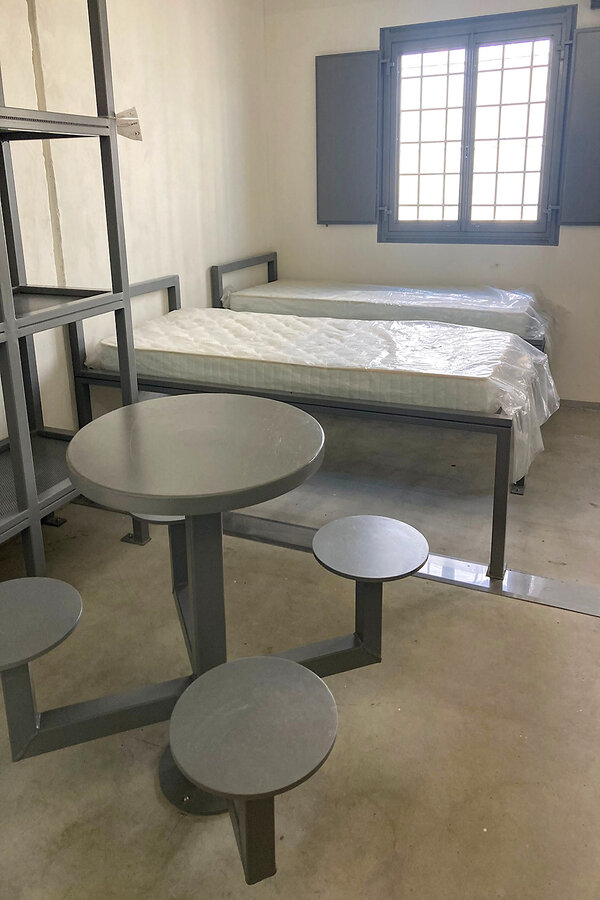
Out of sight, out of mind
Nonetheless, some analysts say the concepts underpinning the Albania-Italy deal will likely remain in play. The Italian project echoes the United Kingdom’s plans to send asylum-seekers to Rwanda. The British Parliament approved the idea, but execution stalled due to legal challenges. New British Prime Minister Keir Starmer scrapped the plan in July.
Replicas of the Albania deal appear likely despite the legal and political challenges they would face. Many governments like the “out of sight, out of mind” approach.
“Many member states want to pursue a similar model,” says Hanne Beirens, director of the Brussels-based nongovernmental organization Migration Policy Institute Europe. “The question is not whether the political interest will be maintained, but whether it will be feasible to implement.”
“At this moment, almost all EU leaders are modifying ... their stances on migration, adopting a more restrictive approach and even expressing doubts about multiculturalism,” notes Dr. Nogueira Pinto.
Last April, the EU adopted a new pact on migration and asylum, creating a Europe-wide system designed to speed up asylum procedures, among other goals. It leaves room for governments to offshore migrant processing and holds out the prospect that more failed asylum applicants will be returned to their home countries – an ambition close to Ms. von der Leyen’s heart.
Europeans are deeply influenced by the memory of 2 million people arriving in the EU in 2015-16. This triggered a “never again” mindset, Dr. Beirens suggests, and pressure rose for governments to impose stricter controls on economic migration.
That focus was sharpened, she adds, by the post-COVID-19 surge in migrant crossings. Austria, for example, is experiencing a wave of migrants not seen since 2015-16. That trend, combined with major EU elections, has pushed migration up the broader political agenda.
Across the continent, the mood is changing. Countries that once upheld the EU asylum system, such as Germany, now question their capacity to manage further influxes, especially after the arrival of Ukrainian refugees. Germany has reintroduced border controls, citing its overwhelmed asylum systems.
The Netherlands, traditionally a supporter of EU-wide migration policies, recently asked to be allowed to opt out of the EU migration pact. The coalition government dominated by far-right politician Geert Wilders is now floating the idea of sending rejected asylum-seekers to Uganda.
And as increasing numbers of Belarusians try to get into Poland, Warsaw wants to temporarily suspend the right to asylum.
“A series of proposals are being made that no longer seem to account for the rules and basic principles that have been laid down in EU migration frameworks for the last three decades,” says Dr. Beirens. “It is really quite a drastic change that we have seen in a very short period of time.”

Amid 2024 election, civics classes prove a draw for high schoolers
An unusual election year is providing teachers with something they need: engaged students. Here’s why some high school civics classes keep teens coming back for more.

- Quick Read
- Deep Read ( 5 Min. )
Every four years, the presidential election energizes civics education. It presents a natural opportunity for educators to discuss topics such as the Electoral College, campaign finance, and the policy issues being debated – even if they say it has gotten trickier in recent years.
Learning about elections and the democratic process can lead to greater civic engagement among young people. A fringe benefit, though, may be student engagement. In an age of chronic absenteeism, some educators are finding that leaning into election topics piques students’ interests and keeps them motivated to learn.
So far this academic year, Lawson Waldrop, a 12th grader in Bar Harbor, Maine, says she has barely missed a day of school. She’s been drawn to a course about the election at Mount Desert Island High School.
“It feels like the most important class to me,” says Lawson, who turned 18 over the weekend. “English is cool and all, but this is, like, real-world stuff that I need to know, especially because I’m going to be partaking in the election.”
Amid 2024 election, civics classes prove a draw for high schoolers

Lawson Waldrop used to have a spotty attendance record. So far this academic year, the 12th grader in Bar Harbor, Maine, says she has barely missed a day of school.
What’s the gravitational pull bringing her to class? A nine-week elective course all about the upcoming election.
“It feels like the most important class to me,” says Lawson, who turned 18 over the weekend. “English is cool and all, but this is, like, real-world stuff that I need to know, especially because I’m going to be partaking in the election.”
Every four years, the presidential election energizes civics education. It presents a natural opportunity for educators to discuss topics such as the Electoral College, campaign finance, and the policy issues being debated – even if they say it has gotten trickier in recent years. Nearly a third of principals surveyed in August by EdWeek Research Center say a “challenging” or “very challenging” obstacle to civics education has been the notion that it’s too political or controversial.
Still, experts say learning about elections and the democratic process can lead to greater civic engagement among young people. A fringe benefit, though, may be student engagement. In an age of chronic absenteeism, some educators are finding that leaning into election topics piques students’ interests and keeps them motivated to learn.
When students have a chance to talk about their identity and values, it breeds engagement both inside and outside the classroom, says Adrianne Billingham Bock, director of curriculum and implementation for the Harvard University-based Democratic Knowledge Project. The group partners with educators to co-design civics lessons.
“Students see and are able to really bring who they are and what matters to them into the classroom,” she says. “We know that supports authentic civic engagement as well.”
It’s also a chance for students to learn about the nuts and bolts of the election process itself.
In 2022, less than a quarter (22%) of eighth graders demonstrated civics proficiency on the National Assessment of Educational Progress, known as “the nation’s report card.” The relatively low percentage underscores what educators and civics advocates say is a concerning trend for democracy in the United States as a whole.
In Bar Harbor, Maine, the Election Year class debuted this fall at Mount Desert Island High School. It joined the school’s roster of other niche electives such as courses on the Holocaust, Civil War, Vietnam War, forensics, astronomy, and outdoor science.
“It’s not that they’re not rigorous, but it’s not your typical world history or chemistry or something that everybody takes,” Principal Matt Haney says. “If you signed up for this class, it’s because you’re interested in it. It gets to be a great learning environment when everybody wants to be there.”
In Wyoming, encouraging informed voters
More than 2,000 miles to the west, Principal Katie Law is deploying a similar strategy at Arapaho Charter High School in Arapahoe, Wyoming. The school serves about 55 students, most of whom belong to the Eastern Shoshone and Northern Arapaho tribes. Since taking on the leadership role nearly seven years ago, Ms. Law has been on a mission to boost student attendance and, ultimately, the school’s graduation rate.
The former social studies teacher has found that emphasizing the upcoming election – and preparing eligible students to vote – has helped. She encourages her students to be informed voters.
“You’re not going to be informed if you’re not coming to school,” Ms. Law says.
Last month, her students watched and analyzed the debate between former President Donald Trump and Vice President Kamala Harris. Beforehand, they jotted down the issues they hoped to hear discussed and, afterward, reflected on what the candidates actually debated.
Information about local candidates, tribal elections, ballot initiatives, and the U.S. party system plays a role in the educational run-up to the election, too. Ms. Law also asks students to think about their own values and causes. She says many point to issues such as mental health or missing and murdered Indigenous people. In mid-October, eligible students – based on age and tribal enrollment – participated in a tribal primary election.
The grand finale, of course, comes on Election Day itself. Ms. Law says students who are 18 years or older plan to cast their ballots at the school campus, which is a polling location, and then visit a bigger voting center to see the “buzz” on Nov. 5. For a previous election, students dressed in tribal-inspired clothing, voted at a county courthouse, posed for photos afterward, and then stopped at Starbucks for a postvote treat.
It’s the culmination of an effort that Ms. Law hopes will pay dividends for her students throughout their lives.
“If you want your voice heard or you want change, step one is voting,” she says.
While the election may be a hook for student engagement, the classroom can also provide a safe forum for children and teens to discuss their views and learn from their peers’ perspectives as well. The polarized national discourse certainly may cause some hesitation among teachers to dive into those discussions, says Ms. Billingham Bock of the Democratic Knowledge Project.
“I also think that civics teachers really know that part of their responsibility [is] to teach about elections and to set agreements on how we talk to one another in our community,” she says.
Modeling civil discourse
Elana Diaz, who teaches the Election Year course in Maine, says she and her teaching assistant, Megan Leddy, strive to model civil discourse. They bounce ideas back and forth during classroom discussions. And the duo hasn’t shied away from thorny topics like how the Israel-Hamas war or immigration policy may affect upcoming elections at the national, state, and local levels.
As for engagement, Ms. Diaz credits the student-driven nature of the class with helping. She crafts lesson plans around what students already know, want to know, or where their interests lie.
“There’s an urgency that’s lacking sometimes and a disconnect between learning about the past and applying it to the future,” she says. “And so this class is just an amazing opportunity to talk about important issues.”
Even if the candidates themselves sometimes avoid doing so. Isa Raven, a 12th grader who is taking the course, says analyzing the recent Trump-Harris debate ended in disappointment.
“I felt like both Trump and Harris would make a point about their policy, but then they just go off and they’d start insulting each other,” she says.
The 17-year-old can’t vote in this year’s election. Even so, she still wanted to hear more about the candidates’ plans if elected.
Isa says she appreciates that the course encourages thoughtfulness and discussion as opposed to certain core subjects, where students are just chasing a high grade.
“This is nice,” she says, “because we can be like, ‘OK, the debate was last night. Let’s just chat about it.’”

Podcast
Sifting hopes and realities for Election 2024
How are the logistics of voting playing out in key states like Georgia, and what might U.S. voters expect near the finish line? We looked at those questions against a backdrop of rumors, mistrust, and concerns – about postvote chaos, and about the robustness of a strained political process. Second of two parts.
After weathering a devastating hurricane, the battleground state of Georgia faced searing controversy over election rules, just days before a critical presidential vote.
Last minute rule changes by the GOP-controlled state election board, which mandated hand counts of ballots on election night, were opposed by the state’s Republican secretary of state and attorney general, as well as by county election officials. Last week, these changes were blocked by the courts, but the Georgia Republican Party and others say that they’re going to appeal.
“That level of uncertainty is problematic both for the folks who actually have to execute the election as well as normal voters who are just hoping to have an accurate count they can trust in Georgia,” says Cameron Joseph, a Monitor senior political reporter, on our podcast.
“It’s building towards a postelection situation, especially if this is a close election, that could be really fraught,” he adds.
Delays in counting votes in recent close elections encourage claims of conspiracy and voter fraud, in Georgia and elsewhere across the country. “We’re serious when we say free, fair, and fast,” Secretary of State Brad Raffensperger told the Monitor. – Gail Chaddock and Jingnan Peng
Find story links and a transcript here.
Election Unprecedented, Part 2

Difference-maker
Many Nigerian girls have been forced to leave school. Mentors help them return.
Many Nigerian girls displaced by insurgency don’t attend school. “Safe space” educational sessions are giving them access to education again.

- Quick Read
- Deep Read ( 5 Min. )
-
By Kate Okorie Contributor
Aye Habila, a veteran mentor for the Stand With a Girl Education Project (SWAGEP), is leading what the initiative calls a “safe space” session for a group of 14- and 15-year-old girls who live in the Wassa camp for people who are displaced. A good-natured argument breaks out over the meaning of “negotiation.”
“The girls want a relatable definition,” Rose Geoffrey, Ms. Habila’s assistant, tells her. Ms. Habila then compares “negotiation” to haggling in the market – a familiar scenario for many of the girls, as their parents often send them out to hawk goods. Some girls request a translation from Ms. Habila in Hausa, their native language. One asks for the English definition to be repeated, and then lurches toward her bag for a book and pen to write it down.
The biweekly sessions are a key component of SWAGEP, which enrolls out-of-school girls who live in the Wassa camp and gets them ready for formal education.
“The safe-space curriculum is girl-centered, emphasizing life skills, numeracy, and literacy,” says Margaret Bolaji, the founder of SWAGEP.
Many Nigerian girls have been forced to leave school. Mentors help them return.
At 2 o’clock on a Friday afternoon, a group of teen girls is gathered in an almost bare, sun-dappled classroom on the outskirts of Abuja, Nigeria’s capital. The walls are lined with handwritten cardboard posters. One of them displays a sequence of numbers in descending order, another lists two-letter English words, and beside those is a chart titled “Options for Making Money.”
Aye Habila, a veteran mentor for the Stand With a Girl Education Project (SWAGEP), is leading what the initiative calls a “safe space” session for this group of 14- and 15-year-olds who live in the Wassa camp for people who are displaced. Soon, a good-natured argument breaks out over the meaning of “negotiation.”
“The girls want a relatable definition,” Rose Geoffrey, Ms. Habila’s assistant, tells her. Ms. Habila then compares “negotiation” to haggling in the market – a familiar scenario for many of the girls, as their parents often send them out to hawk goods. Some girls request a translation from Ms. Habila in Hausa, their native language. One asks for the English definition to be repeated, and then lurches toward her bag for a book and pen to write it down.
The biweekly sessions are a key component of SWAGEP, which enrolls out-of-school girls who live in the Wassa camp and gets them ready for formal education. The sessions are held in venues arranged by the camp leaders, and cater to four groups of adolescent girls and young women ages 10 to 20.
“The safe-space curriculum is girl-centered, emphasizing life skills, numeracy, and literacy,” says Margaret Bolaji, the founder of SWAGEP.

Forced out by insurgency
In 2014, the same year that the abduction of nearly 300 girls from a school in Chibok in northern Nigeria grabbed international headlines, Mary Musa and her family were displaced from their community in Borno state by the Boko Haram militant group. Many families in the Wassa camp share similar stories.
After settling in the camp, Ms. Musa’s parents managed to enroll her in school. But their meager income covered her education only through the junior secondary level. She then spent three years at home until SWAGEP intervened. Now 18 years old, Ms. Musa is approaching her final year of secondary education.
Globally, 250 million children are out of school, with 1 in every 5 of these children living in Nigeria, according to UNICEF. Girls have a higher out-of-school rate in Nigeria, particularly the northern region.
“In addition to insurgency, cultural norms, negative bias towards female empowerment, and poverty contribute to the northern region’s low female education rate,” says Faith Adamu, the Nigeria-based education officer at the Norwegian Refugee Council, an independent humanitarian organization that helps people who have been displaced. Ms. Adamu previously spent nine years at the Center for Girls Education, an organization based in northern Nigeria, developing projects to support adolescent girls. Ms. Bolaji had sought help from the center while developing the safe-space curriculum for SWAGEP.
Before launching SWAGEP in 2021, Ms. Bolaji carried out a survey and found that about 600 girls in the Wassa camp were out of school. “The sad reality is that most of them are likely going to be married off before they turn 18,” she says.
Despite similar conditions in other camps, Ms. Bolaji chose to focus on Wassa. “They gave us the warmest welcome,” she says.
The first group of girls enrolled in schools was supported with money from Ms. Bolaji’s savings and funds raised from her friends and family members. SWAGEP also “organized online campaigns asking people to support a girl’s tuition fees, even if only for a single school term,” she says.

“She goes the extra mile”
After 12-year-old Hassana Ahmadu completed fourth grade, her parents told her that they could no longer afford to sponsor both her education and her brothers’. “They asked me to drop out since I was female,” she says.
After two years at home, Hassana, who wants to be a nurse, learned about the safe-space sessions from the previous cohort and applied. Her mentor, Christine Ibezim, has been impressed by her progress. “She goes the extra mile to communicate in English,” Ms. Ibezim says.
Last year, SWAGEP received significant funding from EMpower, an international, youth-focused foundation. This coincided with the establishment of the safe-space program, which has activities similar to a traditional classroom’s. But Ms. Bolaji is quick to point out that they are not the same.
“The facilitators here are called mentors, not teachers,” she says. She explains that the girls are also exposed to vocational skills. In June, the girls went on an excursion to a shopping complex in Abuja – a rare experience for most of them. “It was an eye-opener for the girls,” Ms. Bolaji says.
Ms. Adamu adds, “The safe space covers topics outside the scope of formal education.” The life-skills curriculum includes areas such as communication, self-esteem, and self-care. Within the past year, Ms. Adamu worked with Ms. Bolaji to replicate the program in a camp in Borno.
The safe-space sessions run for six months, concluding in August, just before a new school year starts. So far, 75 girls total from the Wassa camp have been registered, with 10 graduating from the program and seven of those currently enrolled in school.

Ms. Bolaji aims to help 1,000 girls return to school. “We are not on track,” she says, rubbing her thumb against her other fingertips. “We didn’t anticipate the high costs,” including for transportation and random fees charged by schools, she explains.
Ms. Bolaji says she believes the situation would improve if the government established a school in the camp, in line with national policy recommendations. In 2021, the government introduced a pilot education program in the camp, but it did not offer classes beyond third grade.
Nongovernmental organizations “can’t do everything; they exist to complement government efforts,” Ms. Adamu says. After the first year of the coronavirus pandemic, “Donors cut down on funding, hence the need for a systems approach involving parents, [the] community, and policymakers,” she explains.
Ms. Bolaji notes that she has had more success getting support from the Wassa community than from the government. Among the program’s volunteers is the camp’s chair, M. Bitrus Geoffrey, who was won over by SWAGEP’s consistency. “Some organizations come once, and you never see them again,” he says.
Back in the classroom, Ms. Habila asks the girls to name places where they feel safe.
“The mosque,” a girl blurts out.
“Church,” another chimes in.
A third girl says softly, “Here.”
“The safe space has been magical,” says Ms. Bolaji, her eyes lighting up. “And the girls? They’re our best teachers.”
Other headline stories we’re watching
(Get live updates throughout the day.)The Monitor's View
In Europe, a nod to honest leaders
- Quick Read
- Deep Read ( 2 Min. )
-
By the Monitor's Editorial Board
One of Europe’s most crucial votes this year – an Oct. 20 referendum in Moldova on whether to eventually join the European Union – ended up with a squeak-by approval of just over 50%. The slim margin of victory came as a shock. Years of polling indicated strong support for EU membership in one of the Continent’s smallest and poorest countries.
Yet a closer look suggests that the win was quite remarkable, only confirming why so many countries in Eastern Europe seek to live under EU values.
An estimated 10% of Moldova’s electorate was targeted with bribes from inside Russia to vote against EU membership. Such wholesale corruption of low-income citizens – costing some $16 million in bribe money – is exactly why a majority of Moldovans want to join the graft-fighting bloc. Without the bribery, the victory margin might have been much wider.
Perhaps just as remarkable in the referendum was a high turnout of voters under 35 years old. That rings true across many countries in the region. A new survey of young people ages 14 to 29 in a dozen countries from Albania to Turkey finds that nearly two-thirds say their biggest concern is corruption.
In Europe, a nod to honest leaders

One of Europe’s most crucial votes this year – an Oct. 20 referendum in Moldova on whether to eventually join the European Union – ended up with a squeak-by approval of just over 50%. The slim margin of victory came as a shock. Years of polling indicated strong support for EU membership in one of the Continent’s smallest and poorest countries.
Yet a closer look suggests that the win was quite remarkable, only confirming why so many countries in Eastern Europe seek to live under EU values.
An estimated 10% of Moldova’s electorate was targeted with bribes from inside Russia to vote against EU membership, according to officials. Such wholesale corruption of low-income citizens – costing some $16 million in bribe money – is exactly why a majority of Moldovans want to join the graft-fighting bloc. Without the bribery, the victory margin might have been much wider.
After the referendum, Moldova’s pro-EU and Harvard-trained president, Maia Sandu, explained the task ahead. “Unfortunately, the justice system failed to do enough to prevent vote-rigging and corruption,” she told a news conference. “Here, too, we must draw a line, correct what went wrong, and learn the lesson. We heard you: we know we must do more to fight corruption.”
Perhaps just as remarkable in the referendum was the relatively high turnout of voters under 35 years old. That rings true across many countries in the region. A new survey of young people ages 14 to 29 in a dozen countries from Albania to Turkey finds that nearly two-thirds say their biggest concern is corruption – even more than employment, climate change, and other worries. In other words, a desire for honesty and transparency in government is driving change in these countries, as it is in Moldova.
“The prospect of EU membership maintains a high level of optimism among young people in non-member countries,” stated the survey, which was commissioned by the Friedrich-Ebert-Stiftung, a German foundation. “Most young people in the region adhere to democratic values despite a general decline in trust in democracy as the preferred form of government.”
One notable find among youth: “Those with higher levels of fear of joblessness share a stronger belief in democracy as a favourable political system.” As see in Moldova’s vote, young people in southeast Europe embrace pro-democratic values, especially civic equality and rule of law, that nurture honest governance.

A Christian Science Perspective
Each weekday, the Monitor includes one clearly labeled religious article offering spiritual insight on contemporary issues, including the news. The publication – in its various forms – is produced for anyone who cares about the progress of the human endeavor around the world and seeks news reported with compassion, intelligence, and an essentially constructive lens. For many, that caring has religious roots. For many, it does not. The Monitor has always embraced both audiences. The Monitor is owned by a church – The First Church of Christ, Scientist, in Boston – whose founder was concerned with both the state of the world and the quality of available news.
From anger to peace
- Quick Read
- Read or Listen ( 1 Min. )
Gaining an understanding of God as Love enables us to move past anger and find real unity and progress.
From anger to peace
Anger can seem like a logical response when a friend, a politician, a coworker, hurts us. It can feel automatic, unavoidable, maybe even beneficial. But experience shows us it never brings lasting benefits. Instead, God can lift us out of anger’s dead end.
We’ve collected a few examples from the archives of The Christian Science Publishing Society that show how turning away from frustration and pain to God’s everlasting love brings peace and healing.
The author of “We don’t have to resign ourselves to anger” found that we can respond to injustices with love, as Jesus showed, and this brings protection and peace.
“Do we have to feel offended?” shows how the willingness to feel and know God’s ever-presence and complete power erases the need for anger, and heals us.
In “Empowered to not indulge in anger,” the author shows that prayer can lift not only us but also others out of outrage to a clearer sense of everyone’s innocent individuality, expressing God.
“Losing anger in Love” shares the insight that there’s no room for anger in who we really are, the children of divine Love.

Viewfinder
Lights (still) out

A look ahead
We’re so glad you could join us today. We hope you’ll come back tomorrow for our second of three stories this week about a crisis that has largely escaped world attention: the war in Sudan. We’ll be looking at emergency response rooms, the Nobel Prize-nominated efforts by displaced people to run community kitchens and provide aid to one another.



